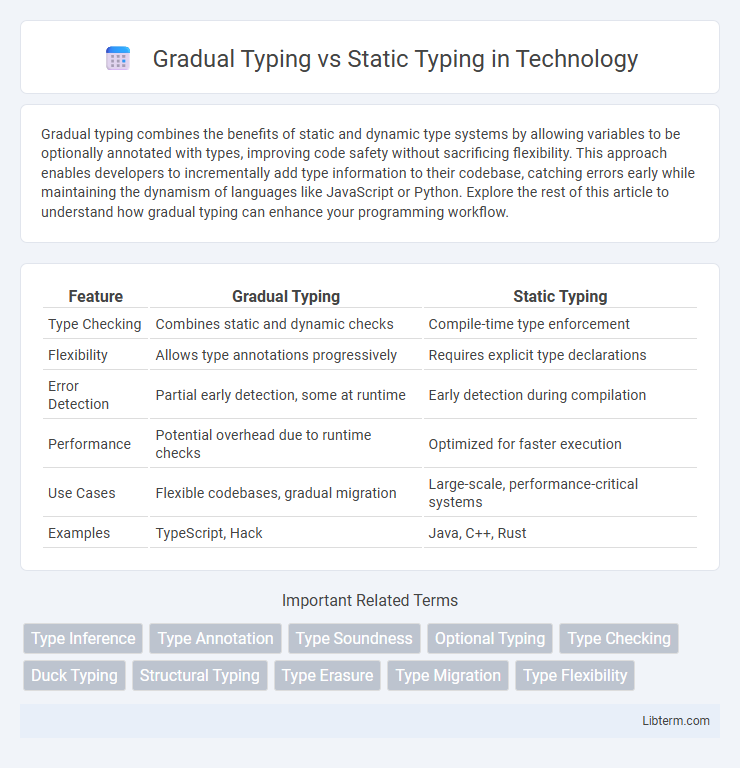Gradual typing combines the benefits of static and dynamic type systems by allowing variables to be optionally annotated with types, improving code safety without sacrificing flexibility. This approach enables developers to incrementally add type information to their codebase, catching errors early while maintaining the dynamism of languages like JavaScript or Python. Explore the rest of this article to understand how gradual typing can enhance your programming workflow.
Table of Comparison
| Feature | Gradual Typing | Static Typing |
|---|---|---|
| Type Checking | Combines static and dynamic checks | Compile-time type enforcement |
| Flexibility | Allows type annotations progressively | Requires explicit type declarations |
| Error Detection | Partial early detection, some at runtime | Early detection during compilation |
| Performance | Potential overhead due to runtime checks | Optimized for faster execution |
| Use Cases | Flexible codebases, gradual migration | Large-scale, performance-critical systems |
| Examples | TypeScript, Hack | Java, C++, Rust |
Introduction to Gradual Typing and Static Typing
Gradual typing bridges dynamic and static typing by allowing developers to specify types incrementally, enabling flexibility during development while improving code safety. Static typing enforces type checks at compile-time, catching errors early and enhancing performance but requires complete type annotations upfront. Understanding the balance between gradual typing's adaptability and static typing's strictness helps optimize code reliability and maintainability.
Defining Gradual Typing: Concepts and Mechanisms
Gradual typing integrates static and dynamic typing by allowing developers to specify type annotations incrementally within the same codebase, facilitating a smooth transition from flexible dynamic typing to more rigid static typing. This approach employs a type system that supports both precise types and an implicit "dynamic" type, enabling seamless interoperability and type checking at compile time for annotated parts while deferring checks for untyped sections until runtime. Key mechanisms include type consistency, which governs safe interactions between typed and untyped code, and runtime casts that enforce type safety across boundaries, addressing the limitations of purely static or dynamic systems.
Exploring Static Typing: Key Features and Benefits
Static typing enforces type constraints at compile time, enabling early error detection and improved code reliability. Key features include strict type annotations, type inference mechanisms, and comprehensive compile-time checks that prevent runtime type errors. Benefits of static typing encompass enhanced code maintainability, optimized performance through early optimizations, and robust tooling support such as intelligent code completion and refactoring capabilities.
Major Differences Between Gradual and Static Typing
Gradual typing combines the flexibility of dynamic typing with the safety of static typing by allowing types to be partially specified and checked at compile-time or runtime, while static typing enforces type rules strictly at compile-time, preventing type errors before execution. Gradual typing supports seamless integration of dynamically typed code into statically typed environments, enhancing code maintainability and refactoring, whereas static typing demands complete type annotations that improve performance and early error detection. The major difference lies in the trade-off between runtime type checks in gradual typing and compile-time guarantees in static typing, impacting debugging, development speed, and system robustness.
Popular Languages That Support Gradual Typing
Gradual typing combines the flexibility of dynamic typing with the reliability of static typing, allowing developers to incrementally annotate types in their code. Popular languages that support gradual typing include TypeScript, Dart, and Python with type hints, enabling smoother transitions from dynamic to static typing without sacrificing code readability or performance. These languages enhance developer productivity by catching type errors early while maintaining the agility of dynamic languages.
Advantages of Gradual Typing in Software Development
Gradual typing combines the flexibility of dynamic typing with the safety of static typing, enabling developers to incrementally add type annotations to existing codebases without requiring a full rewrite. This approach enhances code maintainability and reduces runtime errors by catching type mismatches early during development while preserving rapid prototyping capabilities. Gradual typing supports smoother team collaboration by accommodating diverse coding styles and improving the integration of legacy systems with new type-safe modules.
Benefits of Static Typing for Code Reliability
Static typing enhances code reliability by enforcing type constraints at compile time, reducing runtime errors and improving early bug detection. It enables better tooling support, such as autocompletion, refactoring, and type checking, which increases developer productivity and code maintainability. Strong type systems facilitate clearer documentation and self-explanatory code, minimizing ambiguities and improving team collaboration.
Challenges and Limitations of Gradual Typing
Gradual typing faces challenges such as inconsistent type safety, where dynamic and static code interaction may cause runtime errors that static typing typically prevents. Performance overhead arises from runtime type checks required to enforce type correctness, leading to slower execution compared to purely static type systems. Maintaining code maintainability and tooling support is difficult due to mixed typing paradigms, which complicate type inference and reduce the effectiveness of static analysis tools.
Use Cases: When to Choose Gradual vs Static Typing
Gradual typing is ideal for projects requiring flexibility, such as rapid prototyping, large-scale legacy code integration, or incremental type safety adoption, enabling developers to balance dynamic and static type checks. Static typing excels in safety-critical systems, large codebases with strict type contracts, and performance-sensitive applications, where early error detection and optimized compilation are paramount. Choosing gradual typing suits teams prioritizing agility and code evolution, while static typing benefits scenarios demanding robustness and maintainability.
Conclusion: Selecting the Right Typing Approach for Your Project
Choosing between gradual typing and static typing depends on the specific needs of your project, including factors like codebase size, team experience, and runtime performance requirements. Gradual typing offers flexibility by allowing incremental type enforcement, which suits evolving projects or those transitioning from dynamic to static typing. Static typing ensures early error detection and robust type safety, making it ideal for large, complex systems requiring maintainability and predictability.
Gradual Typing Infographic

 libterm.com
libterm.com